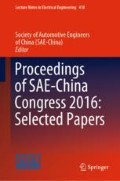Abstract
Permanent magnet synchronous motor (PMSM) is widely used in the electric vehicle as a drive motor. For specific application requirements of the electric vehicle motor system, there are new faults and application characteristics in motor system’s three-phase short-circuit. Based on the \( dq \) axis coordinate system mathematical model of PMSM, this paper derives the \( dq \) axis current transient equations of three-phase transient short-circuit with load or without load in initial state. Combined electric vehicle PMSM operating characteristics, based on the typical working conditions, this paper analyzes the influences of motor demagnetization risk in different conditions by comparing the transient current changing process simulation results of different initial transient \( dq \) axis currents. Then according to the characteristics of the three-phase transient short-circuit, designs and builds a test platform, and verifies the correctness of the analysis and mathematical simulation models by testing. It provides an important theoretical analysis and test verification methods for analyzing the electric vehicle PMSM three-phase short-current function and determining the risk of demagnetization.
References
Rosero J, Espinosa AG, Cusido J, et al (2008) Simulation and fault detection of short circuit winding in a permanent magnet synchronous machine (PMSM) by means of fourier and wavelet transform. In: Instrumentation and measurement technology conference proceedings, 2008. IMTC 2008. IEEE. IEEE, 2008, pp 411–416
Jie B, Huichao Z, Xiuhui D et al (2014) Steady-state characteristic analysis and application of PMSM for electric vehicle with symmetrical three-phase short-circuit. Small Spec Electr Mach 42(3):17–20
Hongmei L, Tao C, Hongyang Y (2013) Mechanism, diagnosis and development of demagnetization fault for PMSM in electric vehicle. Trans China Electrotech Soc 28(8):276–284
Chunhong Z, Xin S, Wenming T et al (2009) Calculation and measurement of transient reactance of permanent magnet synchronous motor. Electr Eng 4:14–17
Eilenberger A, Schrodl M (2010) Sudden short-circuit analysis of a salient permanent magnet synchronous machine with buried magnets for traction applications. In: 14th International of power electronics and motion control conference (EPE/PEMC), 2010. IEEE, T9-117-T9-120
Mingming H, Xinjun G, Chenghu Z et al (2013) A novel wide speed-range driving system design for electric vehicle. Trans China Electrotech Soc 28(4):228–233
Author information
Authors and Affiliations
Corresponding author
Editor information
Editors and Affiliations
Rights and permissions
Copyright information
© 2017 Springer Nature Singapore Pte Ltd.
About this paper
Cite this paper
Wang, S., Lu, C., Wang, X., Zhao, H. (2017). Analysis and Test Research for Three-Phase Short-Circuit of Permanent Magnet Synchronous Motor for an Electric Vehicle. In: Proceedings of SAE-China Congress 2016: Selected Papers. SAE-China 2016. Lecture Notes in Electrical Engineering, vol 418. Springer, Singapore. https://doi.org/10.1007/978-981-10-3527-2_9
Download citation
DOI: https://doi.org/10.1007/978-981-10-3527-2_9
Published:
Publisher Name: Springer, Singapore
Print ISBN: 978-981-10-3526-5
Online ISBN: 978-981-10-3527-2
eBook Packages: EngineeringEngineering (R0)

